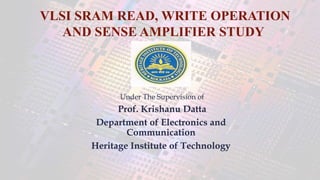
SRAM read and write and sense amplifier
- 1. Under The Supervision of Prof. Krishanu Datta Department of Electronics and Communication Heritage Institute of Technology VLSI SRAM READ, WRITE OPERATION AND SENSE AMPLIFIER STUDY
- 2. •ABRARUL HAQUE (125243) •DEBASMITA SIKDER (125222) •JAYEESHA CHAKRABORTY (125241) •SOUMYAJIT LANGAL (125239 Presented By:
- 3. LITERATURE SURVEY • In the initial phase of our project we had gone through several articles from the web resources. • For better understanding we have gone through “CMOS VLSI Design A Circuits and Systems Perspective” by Weste Harris Banerjee. • And after all we are highly grateful to our mentor Prof. Krishanu Datta for the detailed and complete understanding of our project.
- 4. • Focus to design : 32 KB SRAM memory array • Memory Size : 512*512 (512 rows & 512 columns) • Tool used : Cadence Virtuoso • Technology used : Cadence gpdk45nm • Supply Voltage applied : 1.1V • Comparative Study : a) Differential Sense Amplifier VS. b) Latch Based Sense Amplifier • Key Parameters to analyze performance : a) Access time b) Speed c) Power consumption PROJECT OVERVIEW
- 5. 6 TRANSISTOR SRAM CELL
- 7. ROW DECODER AND COLUMN DECODER
- 8. CRITICAL PATH MODELLING Schematics to be designed on the critical path : Precharge circuit RC model for bitline and bitline_bar Column multiplexer for write operation Write enable circuit Column multiplexer for read operation Sense Amplifier For write operation For read operation
- 10. RC MODELLING OF BIT LINES PROBLEM How to model 512 bit line segments on a single column ?? OPTIMUM SOLUTION Grouping 64 such bit line segment to form a segment and 8 such segments SOLUTION 2 Grouping 512 bit line segments to an equivalent one Equivalent bit line represented using Pi model and source to drain capacitance of NMOS SOLUTION 1 Modeling for each of 512 bit line segments
- 11. SPECIFICATIONS GIVEN Parameter Value Channel length(L) of Memory cell MOS 45nm Channel width(W) of Memory cell MOS 120nm Area Formula L=√A/12 Resistance for mid-level wire 1.01 Ω/ µm for 50nm Capacitance for mid-level wire 0.294 fF/ µm for 50nm
- 12. CALCULATION FOR MODELING Sl. No. Name of the parameter Specification 1. Cell Area (A) A=X2=144*L2 =144* 45nm2 2. Length of each side of the cell (X=√A) X=0.54 µm 3. Using 20% guard band(X´=1.2*X) X´=0.648 µm 4. Bitline length per segment (grouped by 64 cells) 64*0.648 µm = 41.472 µm 5. Resistance of Bitline per segment (grouped by 64 cells) 41.472*1.01 Ω=42.3 Ω 6. Capacitance of Bitline per segment: 41.472*0.294 fF=12.1927 fF 7. Source to drain capacitance of pass transistor w=120n*64=7.68u, l=45n
- 14. COLUMN MULTIPLEXER FOR WRITE Input/Output Buffer
- 15. WRITE ENABLE CIRCUIT wrt =1 to enable AND gate
- 16. WRITE STABILITY For successful write operation PMOS PM5 must be weaker than the access transistor NM8. So size of PM5 ≤ size of NM8
- 17. COLUMN MULTIPLEXER FOR READ
- 18. READ STABILITY To read successfully from the cell the driver NM5 must be stronger than the access transistor NM7. So size of NM4 ≥ size of NM7
- 19. SRAM without Sense Amp SRAM with Sense Amp SENSE AMPLIFIER
- 20. TYPES OF SENSE AMPLIFIER SENSE AMPLIFIER DIFFERENTIAL LATCHED
- 21. DIFFERENTIAL SENSE AMPLIFIER Current source senb bit bit_b rout rout_b
- 22. LATCH BASED SENSE AMPLIFIER
- 24. SIMULATION & RESULTS • The constraints are as follows a) Timing of control signals b) Sizing of NMOS & PMOS in critical path • Results include 2 measurements in case of both the sense amplifiers during read operation. a) Delay (the time lag between the wordline activation and the Output from sense amplifier) b)Power (during read operation the amount of power that is consumed by the sense amplifier)
- 25. TIMING DIAGRAM Parameter Logic State Precharge (pre) Active Low Wordline (wl) Active High Multiplexer enable for write (colselw) Active High Write circuit enable (wrenb) Active High Multiplexer enable for read (colselr) Active Low Sense Amplifier enable (senb) Active High For Latched Sense Amplifier For Differential Sense Amplifier Write ReadInitialize ReadWriteInitialize
- 26. SIZING Pi circuit Col. Mux. Write Diff. Sense Amp
- 27. READ SIMULATION For Latch Based Sense Amplifier bit bit_b rout Precharge+Mem cell+pi model Sense Amplifier
- 28. FOR DIFFERENTIAL SENSE AMPLIFIER r_out bit_b bit Precharge+Mem cell+pi model Sense Amplifier
- 29. POWER AND DELAY MEASUREMENT FOR READ TYPE OF AMPLIFIER Average Current (µA) POWER (µWatt) DELAY (pSec) WIDTH (µm) Latched Sense Amplifier 0.8564 0.94 120.2 0.84 Differential Sense Amplifier 12.82 14.1 211.0 7.2
- 30. CONCLUSION Latched base consume 14X less power. Latched based has less READ delay. Latched based has less size. LATCHED DIFFERENTIALVS. LATCHED BASE IS THE BEST